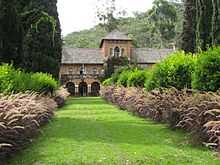Shiwa Ngandu

Decision to settle at Shiwa Ngandu
From his boyhood, Gore-Browne had an ambition to own an estate like that of his aunt, Dame Ethel Locke King, at Weybridge in England. Although comparatively wealthy himself, he could not afford such an estate in Britain. Land in Northern Rhodesia was very much cheaper for white settlers. At the boundary commission he had come to admire the Bemba workers and so he travelled to their country looking for a site. Arriving at Lake Shiwa Ngandu in April 1914 with his Bemba servants and porters, he knew he had found it. World War I intervened but its horrors only increased his desire to return to Shiwa Ngandu and achieve his dream. He also harboured the ideal of establishing a patrician regime of the kind whose time was ending in Britain after the war.
Construction of the estate
Construction of the mansion began in 1920 when Zambia was the British protectorate of Northern Rhodesia. The site was 400 miles from the nearest railhead, a journey of many days over rivers and swamps. At that time there were no roads to the area. As well as building the estate's access roads and bridges, Gore-Browne built roads and bridges for the local colonial authority. Almost everything had to be made on site, including every brick used in the construction. Hundreds of labourers were employed, and with the help of oxen to haul the bricks in scorching heat, a substantial house was constructed within a few years. However, the building work did not stop until the late 1950s; an imposing gatehouse, a tower, colinaded porticoes, courtyards, additional rooms all added to its size and stature.
The house was surrounded by nursery gardens, tennis courts, a walled ladies' garden and much more. The estate followed in the tradition of 19th century utopian model villages like Saltaire and Port Sunlight. The estate had its own schools, hospitals, playing fields, shops, and post office. Workers lived in brick-built cottages and the estate was ruled as a benevolent autocracy — though by a man with a temper ferocious enough to justify the local nickname of Chipembere which means 'rhinoceros'. He was also a very formal man who always wore black tie for dinner, at a table set with family plate and silver – whether he had guests or not.
The estate in Gore-Browne's later life
Shiwa Ngandu's remoteness and isolation from white settler society in Northern Rhodesia's southern half and in Southern Rhodesia gave Gore-Browne a perspective on black Africans which led him to believe the country should develop in a more collaborative direction than the settler-ruled and segregationist Southern Rhodesia and apartheid South Africa. He involved himself in politics as detailed in his biographical article.
The estate never managed to make consistent and steady profits. The soil was too acidic for most crops, and after trying various other sources of revenue, they found a more stable income in the production of essential oils and citrus blossoms especially when the Second World War closed off supplies of essential oils from the rivieras of France and Bulgaria. However, his projects were heavily subsidized by Dame Ethel Locke King, with whom he was obsessively attached and corresponded from his childhood until her death. This source of revenue ended in 1958 when the citrus trees were attacked by a blight.
Stewart Gore-Browne died in Kasama, Zambia in 1967, and to this date is the only white man to have been given a state funeral in the history of Zambia, with a eulogy given by then President Kenneth Kaunda.
Fame and tragedy
After his death the estate was managed by one of his daughters, Lorna, and her husband John Harvey. They had four children, who grew up at the estate. They were filmed by the British Broadcasting Corporation travelogue series Pole to Pole in 1991, which included actor Michael Palin's visit to the estate. But only six months later in 1992, Lorna and John Harvey were murdered at Shiwa Ngandu (Page 340 "The Africa House") by three men who were caught and convicted. They were ANC members living in exile in Zambia. The ANC disavowed any prior knowledge and condemned the murders, and although some property was stolen, possible motives remain speculative.
In the years following the murders the house fell into disrepair.
The present day
Recently Shiwa House has been partially restored and has opened five rooms for paying guests under the name Shiwa Ngandu Manor House. An airstrip has been built for charter flights. The estate's remote beauty is once more accessible to visitors. The grave of Sir Stewart is at rest in the extraordinary African paradise he created. Lorna and John Harvey's sons have reintroduced wildlife, and established a large cattle ranch. Poaching is under control, and the estate is proving to be a significant source of employment in the area.[citation needed]
Photographs of the estate can be seen at the Shiwa Ng'andu website.
References and further reading
- Christina Lamb: "The Africa House". Viking, London 1999
- http://shiwangandu.com/ Shiwa Ng'andu website accessed 5 February 2007
- http://www.zambia-travel-guide.com/bradt_guide.asp?bradt=682 Zambia Travel Guide (Bradt), website accessed 6 February 2007
Coordinates: 11°12′S 31°44′E / 11.200°S 31.733°E